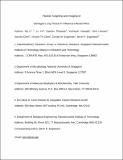Peptide targeting and imaging of damaged lung tissue in influenza-infected mice
Author(s)
Li, Na; Yin, Lu; Thevenin, Damien; Yamada, Yoshiyuki; Limmon, Gino V.; Chen, Jianzhu; Chow, Vincent T. K.; Engelman, Donald M.; Engelward, Bevin P.; ... Show more Show less
DownloadEngelward_Peptide targeting paper and SI.pdf (1.969Mb)
OPEN_ACCESS_POLICY
Open Access Policy
Creative Commons Attribution-Noncommercial-Share Alike
Terms of use
Metadata
Show full item recordAbstract
In this study, we investigate whether pH (low) insertion peptide (pHLIP) can target regions of lung injury associated with influenza infection. Materials & methods: Fluorophore-conjugated pHLIP was injected intraperitoneally into mice infected with a sublethal dose of H1N1 influenza and visualized histologically. Results: pHLIP specifically targeted inflamed lung tissues of infected mice in the later stages of disease and at sites where alveolar type I and type II cells were depleted. Regions of pHLIP-targeted lung tissue were devoid of peroxiredoxin 6, the lung-abundant antioxidant enzyme, and were deficient in pneumocytes. Interestingly, a pHLIP variant possessing mutations that render it insensitive to pH changes was also able to target damaged lung tissue. Conclusion: pHLIP holds potential for delivering therapeutics for lung injury during influenza infection. Furthermore, there may be more than one mechanism that enables pHLIP variants to target inflamed lung tissue.
Date issued
2013-02Department
Massachusetts Institute of Technology. Department of Biological Engineering; Massachusetts Institute of Technology. Department of Biology; Singapore-MIT Alliance in Research and Technology (SMART); Koch Institute for Integrative Cancer Research at MITJournal
Future Microbiology
Publisher
Future Medicine
Citation
Li, Na et al. “Peptide Targeting and Imaging of Damaged Lung Tissue in Influenza-infected Mice.” Future Microbiology 8.2 (2013): 257–269. CrossRef. Web.
Version: Author's final manuscript
ISSN
1746-0913
1746-0921